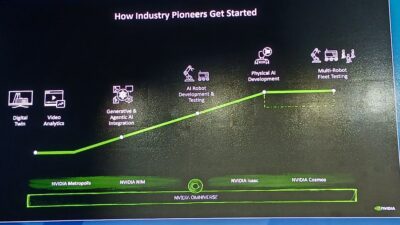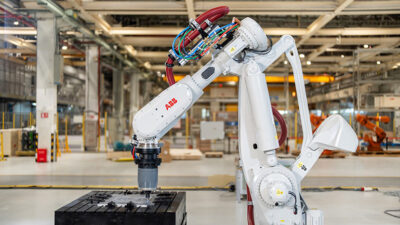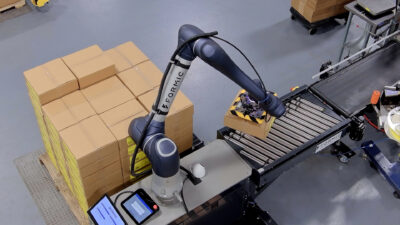Tutorial: When it comes to extreme high-accuracy motion control, such as marking the fiducials on precise linear encoders used to make integrated circuits with critical dimensions at the few tens of nanometers level, temperature variations are often considered the most serious issue. These encoders have to be made with picometer precision.
There are three “danger points” (shown in red) on a robot axis where measurement uncertainty levels can be compromised.
When it comes to extreme high-accuracy motion control, such as marking the fiducials on precise linear encoders used to make integrated circuits with critical dimensions at the few tens of nanometers level, temperature variations are often considered the most serious issue. These encoders have to be made with picometer precision.
On the other hand, when the context is robots used in a CNC machining process at an aerospace company, critical parts likely will have tolerances five or six orders of magnitude coarser than those need for high precision encoder fabrication. Calibration for temperature variations is much less important.
The moral of these stories is that questions about calibration always have to be answered in context.
At the CNC level of precision, absolute encoders providing feedback likely are perfectly stable. They are made of Zerodur, which is a “zero-temperature-coefficient” glass. They are also rotary encoders, which are much less affected by temperature variations than linear encoders. Traditional calibration—which looks at drifts that occur as components age—is unnecessary for the application.
Encoder danger points
Calibration in general, however, does not restrict itself to slow changes due to aging. Anything that can affect accuracy of the final tool position is in the calibration department’s purview. So, it’s important to look for danger points in the structure of a typical robot where measurement errors can arise.
Optical rotary encoders consist of an encoder disk carrying etched fiducials whose movement past a readout sensor produces an output signal. Encoder disks often mount to the housings of the motors driving the axis they serve, with the sensor attached to the output shaft. Barring catastrophic destruction of the encoder disk or failure of the sensor, there are only three places where something can happen to degrade measurement accuracy.
One danger point is where the encoder attaches to the structure. Should the encoder disk slip with respect to the support structure, the measurement would be compromised. Similarly, should the sensor attachment slip with respect to the lever (bell crank, or whatever you want to call it) carrying the tool, the measurement will be compromised. Finally, if the lever arm itself flexes, bends, or changes dimension due to any cause, the CNC tool point will not be where the controller thinks it is.
Both Tom Wyatt, national sales & product manager in Heidenhain’s Automation Division, and Chad Henry, an application engineer at robot maker Stäubli Corp. agree that providing redundant encoder signals is the way to deal with these issues.
Robot controllers can use a redundant signal to keep track of the motion in addition to the absolute encoder signal. Any event (collision with an errant forklift, for example) severe enough to cause the encoder to slip or arm to permanently deform will also cause the redundant signal to miss counts. By constantly monitoring the position reported through redundant channels, the controller can identify encoder-slip events and send up an alarm.
It is unnecessary to “fix” the encoders. Recovering from an encoder slip would simply require finding a new offset value for the absolute encoder and zeroing the relative encoder’s position register.
Author Information
C.G. Masi is a senior editor with Control Engineering . Contact him via email at [email protected] .



